I love the stark realism the words of this title bring to mind. It comes from a phrase in “Seeds of Contemplation” by Thomas Merton: “As long as we are on earth, the love that unites us will bring us suffering by our very contact with one another, because this love is a resetting of a body of broken bones. Even saints cannot live with saints on this earth without some anguish, without some pain at the differences that come between them.”

This spiritual image affords us a super power. We have a potential to have x-ray vision. We can look at other human beings and see the broken bones concealed inside their flesh. They too can see the cracked and fractured bones in our body. One can’t live in this fallen world and not carry inside us a broken nature. Surely, we try to conceal it from the world with all manner of disguises, but it is not hidden for long.

One of my favorite painters is Michelangelo Caravaggio. He lived and painted in the late Renaissance period and is considered the first artist to bring realism to painting. He was a wild man; some even considered him mentally ill. Who knows? He captured a dramatic truth in his paintings that, when viewed, can bore through your soul much like his frequent use of a shaft of light onto the principal subject made more poignant by the vale of blackness around it. Whether Caravaggio fully understood what he was doing or not, so many of the subjects in his paintings are captured in a moment of brokenness. He never sketched before painting. The final version just poured out of him straight onto the canvas in a burst of impetuous fire.
Merton’s “body of broken bones” and Caravaggio’s painting of “The Seven Acts of Mercy” (one of his last paintings) are beautiful reminders of who we are as human beings and how we have opportunities to “reset one another’s bones” in love to paraphrase Merton. All of the images crammed into this painting are the artist’s reflection of Jesus’ admonition in the gospel of Matthew of how we might show mercy to someone: (1 & 2) a woman visits an imprisoned man and gives him milk from her breast; 3) a pilgrim asks for shelter; 4) a saint gives half his robe to a naked beggar; 5) a saint comforts a beggar; 6) Samson drinks from the jawbone of an ass; and 7) two men honor the dead with a respectful burial (the seventh act of mercy was added to this list in the Middle Ages).

All of us should be using our “super power” to see one another’s broken bones, and then pouring ourselves into acts of mercy like Caravaggio poured himself into his paintings. His vision and unbridled passion went straight onto the canvass. So in this painting, Caravaggio had a vision of the brokenness of humanity and re-imagined it through acts of mercy. He had his vision and applied the paint to make it real. It was not real until the brush spread the paint and shaped the images. Our mercy should come without hesitation, without thinking too much about the cost or consequences (sometimes it may be costly, or at the very least, inconvenient). Caravaggio set about staging his models and then brushing the startling images onto the canvass without sketches. It was his mysterious second-nature at work. For most of us acts of mercy are not second-nature. They require developing our x-ray vision, and then an act of will to respond with mercy whenever a human need gives us the opportunity.
We should be clear-eyed and clear-headed about our acts of mercy. They will require something of us, from us. They can be burdensome. They can even be traumatic. Each act will be permanently etched onto our hearts and minds; the more burdensome the act, the heavier the weight of impression onto our souls and the deeper the memory. But our acts of mercy today get handed down to the next generation, and when the next generation sees such actions, they tend to repeat them. These acts of mercy toward others make the best stories…eternal stories. It reveals the best of human connection. It leaves behind the best historical records. It is an act of transference and ritual that can engage the imagination without it being a sentimental response for one’s self-satisfaction. If self-satisfaction is the sole value of your act of mercy, then don’t bother. Just mail in a Hallmark Card.

I recently came across this Flannery O’Connor quote: “The truth does not change according to our ability to stomach it emotionally. A higher paradox confounds emotion as well as reason and there are long periods in the lives of all of us when the truth as revealed by faith is hideous, emotionally disturbing, down-right repulsive…witness the dark night of the soul in individual saints. Right now the whole world seems to be going through a dark night of the soul.” She wrote this some fifty plus years ago. Imagine her reaction to the “dark night” of our world today.
But before we point an accusing finger to the culprits of the present chaos in our world and its collective disregard of truth, we must recognize our own dark hearts and the lies we choose to embrace. Truth may be lying on the ground in a pool of blood but it is still breathing and it is still truth. Just because we might choose to exchange the truth for a lie and attach our personal biases to that lie, does not mean that truth is dead. It does not even mean that the truth is dead in one’s own heart. The faint pulse of eternal truth still beats deep down inside. We must have ears to hear and eyes to see truth. If indeed “the whole world seems to be going through a dark night of the soul,” then what better time to bring the true light into our world by the transforming acts of mercy? Let it be born from an extravagant love, a creative, unconditional love, a foolish love, that can’t be explained but can be quantified. It is that type of mercy God has offered for our broken bones.
Cover Art: Sette opera di Misericordia; Caravaggio; 1607





